From buzz and crew cuts, textured crops and Caesar cuts, to fades and shaved heads, these 15 best haircuts for balding hair combine minimal maintenance, texture, and face-shape harmony. This guide provides clear descriptions, styling tips, and upkeep advice to help you choose and maintain your ideal look.
What to Consider Before Choosing Your Haircut
Before you settle on a style, take a moment to understand your own needs. The right cut not only conceals thinning but also feels comfortable and fits your lifestyle.
Identify Your Stage of Balding
Is your hairline just starting to recede, or are you seeing wider patches at the crown? Early thinning can support longer top lengths, whereas more pronounced loss often calls for shorter, uniform cuts. Knowing exactly where you stand helps you pick a look that works today—and ages well.
Consider Your Face Shape
An oval face enjoys almost every style, while square jaws pair beautifully with textured crops or short fades. Round faces benefit from height on top, and heart shapes gain balance with fuller sides. Match your cut to your bone structure for natural harmony.
Maintenance and Styling Preferences
Ask yourself how much time and effort you’re willing to invest each morning or each month. Buzz cuts demand almost zero styling but regular trims. Longer crops give you more flexibility—and more upkeep. Be honest about your daily routine and budget before committing.
15 Best Men’s Haircuts for Balding Hair (With Photos and Descriptions)
1. Buzz Cut: Clean and Confident
The buzz cut is the go-to for men who want to minimize contrast between thinning and fuller areas. Using a single guard length—typically #1 or #2—all over the scalp creates a uniform look that makes sparse patches almost invisible. It’s unbelievably low-maintenance: you simply rinse and go, with only a quick tidy-up every three to four weeks. Skip the styling products entirely or add a touch of clear, lightweight scalp balm to prevent dryness and irritation.
2. Crew Cut: Classic and Professional
A crew cut leaves a bit more length on top (guard #3 or #4) and tapers the sides (guard #1–2), striking the perfect balance between concealment and style. The slightly longer crown adds natural texture that helps break up thinning lines, while the tapered sides keep the overall shape neat enough for the office. In the morning, run a finger-through with a small dab of matte paste to accentuate the texture without weighing hair down. Plan on a trim every four to six weeks to maintain the clean lines
3. Textured Crop: Adds Volume Naturally
A textured crop relies on choppy, point-cut layers across the top to create lift and movement—ideal if your crown is starting to thin. Your barber will use scissors rather than clippers to pepper in uneven lengths, producing a lived-in finish that tricks the eye into seeing more density. To style, work a pea-sized amount of sea-salt spray or light styling clay through damp hair, then tousle with your fingertips. This cut works especially well on oval and square faces and usually needs a cleanup every five weeks.
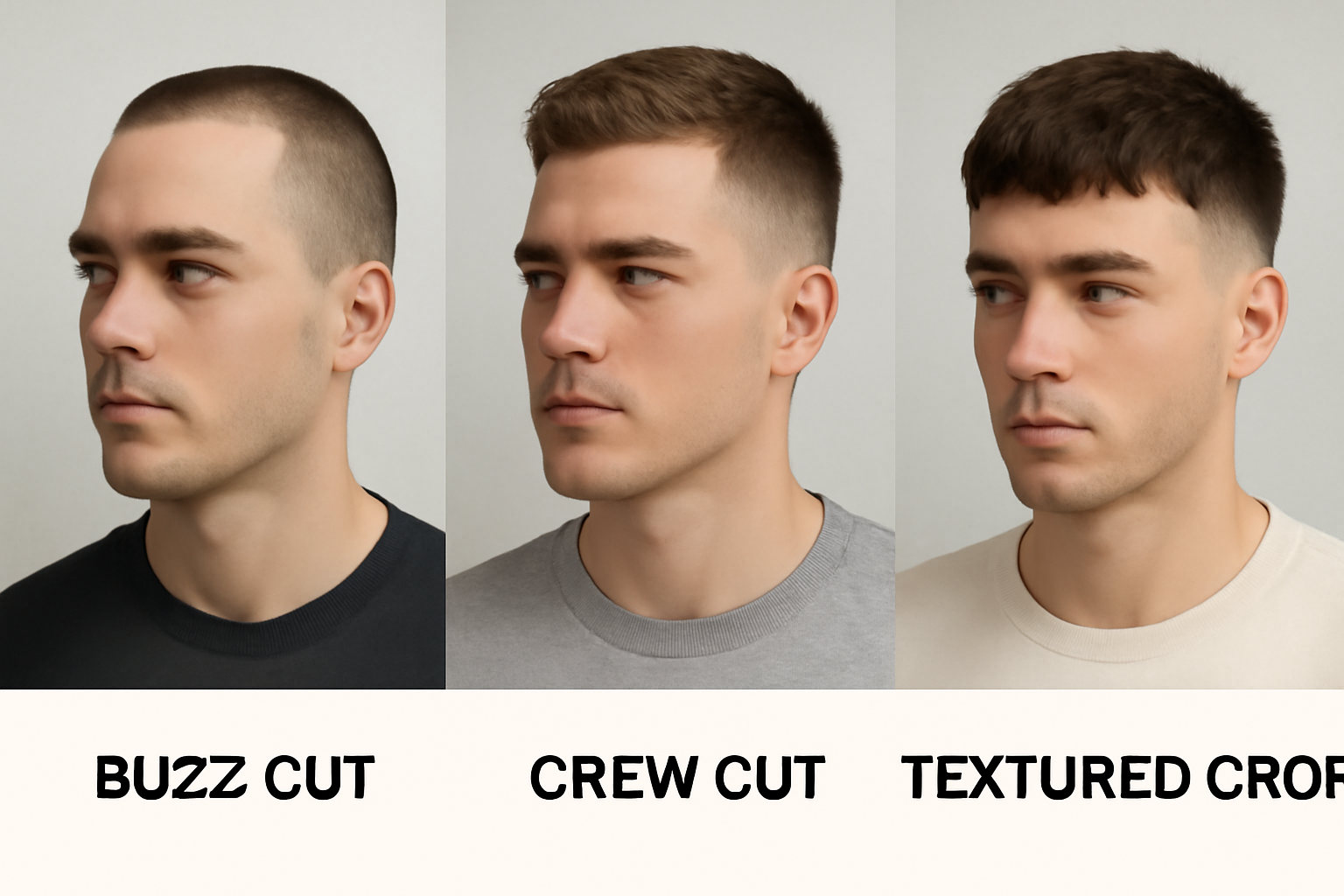
4. Caesar Cut: Stylishly Covers the Hairline
The modern Caesar features a short, horizontal fringe that sits right at the edge of your receding hairline, effectively camouflaging it. Typically cut to about one inch all around, the uniform length means you won’t be fussing with complex styling—just brush the fringe forward and you’re set. A tiny bit of soft cream or fiber helps keep the hair in place without making it look too stiff. Touch-ups are needed roughly every four weeks to preserve the blunt fringe.
5. Short Comb-Over Fade: Modern and Discreet
This style blends a subtle side part with a gentle fade from guard #1 at the temples up to #3 on top, shifting focus away from thinning areas. A light pomade or paste holds strands in a smooth comb-over without leaving greasy residue. The gradual fade hides sparse spots along the temples, while the defined part line lends an air of sophistication. Visit your barber every three weeks to maintain the fade’s crisp gradient.
6. Slicked-Back Undercut: Bold and Sharp
By pairing long hair on top (3–4 inches) with very short, clipped sides, the slicked-back undercut creates strong contrast that draws attention upward, away from the temples. A matte clay worked through damp hair provides hold and texture, and using a blow dryer on low heat helps shape the top without flattening it. This look is best for men whose hair loss is concentrated at the sides rather than the crown. Plan for side-trim touch-ups every two to three weeks and a top trim every six to eight weeks.
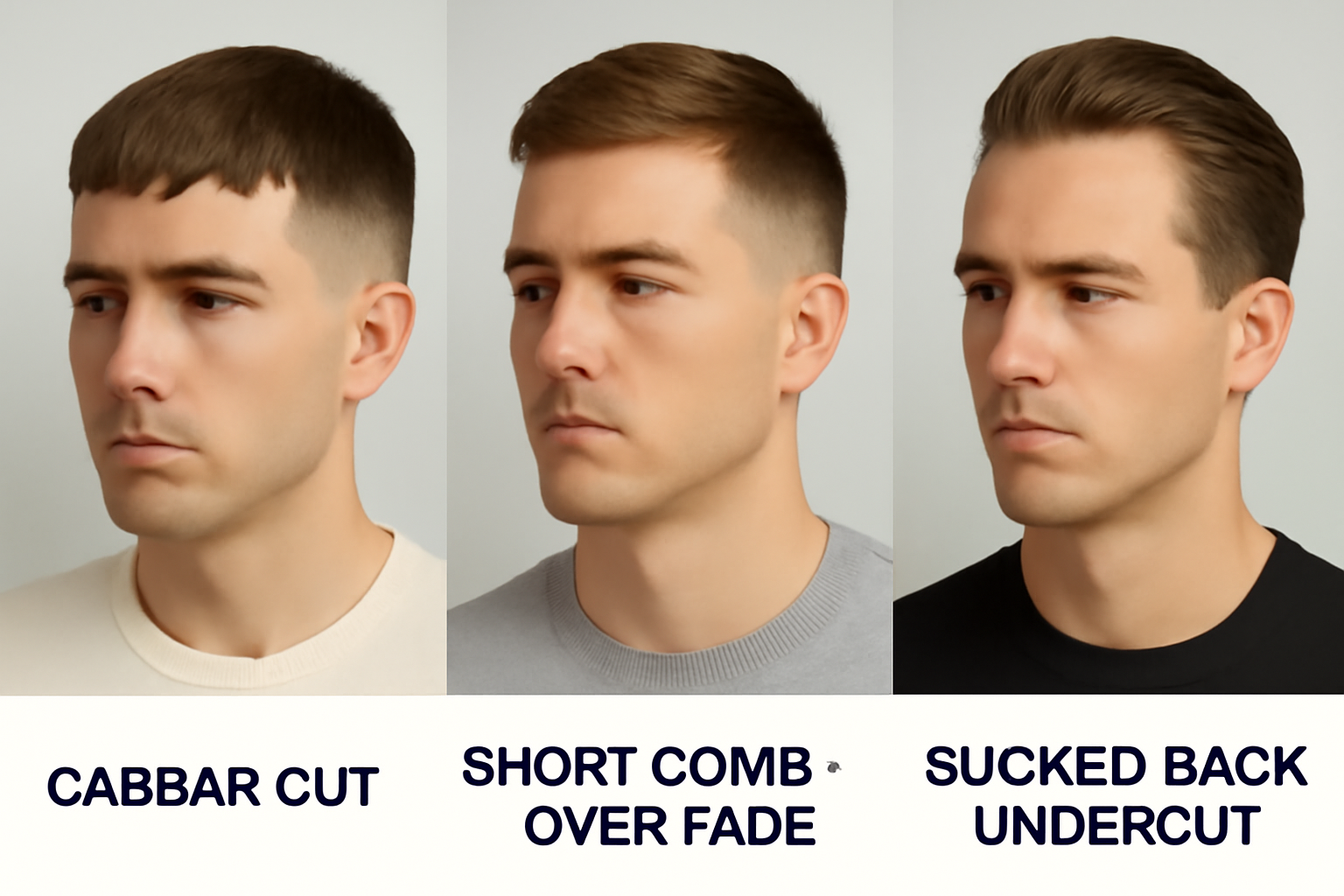
7. Shaved Head with Beard: Embrace the Bold Look
Completely shaving your head with a #0 guard or bare blade removes all unevenness, making hair loss a non-issue. Pair it with a well-groomed beard to frame your face and add character. Daily scalp care—gentle exfoliation, moisturizing with a lightweight lotion, and broad-spectrum SPF—is crucial to keep the skin healthy and avoid irritation. Shave your head once a week for consistency, and trim your beard every few days to maintain a sharp contrast.
8. Ivy League Cut: Smart, Polished Appearance
The Ivy League is essentially a slightly longer crew cut, leaving enough length on top (guard #4–5) to part or comb over, while the sides stay short (guard #2–3). This versatility lets you switch between a neat side part or a tousled look, making it perfect for both boardroom meetings and weekend golf outings. A little styling cream or light wax is all you need to define the part and keep stray hairs in check. Schedule trims every five to seven weeks to hold the shape.
9. Side-Part Fade: Elegantly Conceals Thinning
A sharply defined part line paired with a fade (starting at guard #0 and blending up to #3) draws the eye along the hairline, away from any sparse patches. The clean separation between top and sides creates structure, and a touch of medium-hold pomade enhances shine without slicking down thinning spots. This cut flatters most face shapes, especially square and diamond. Ask for a line-up refresh every three weeks to keep the part crisp.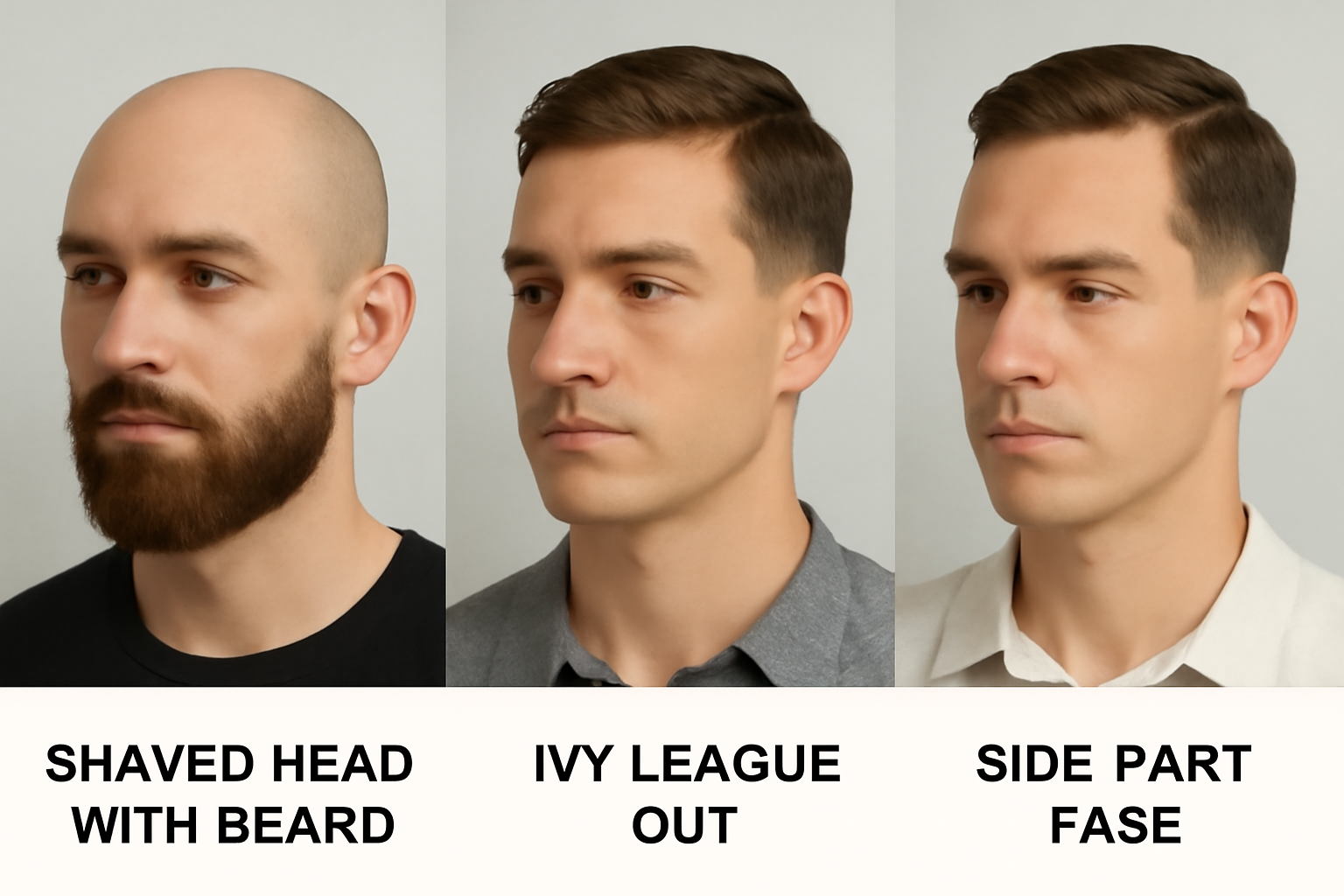
10. Regulation Cut: Military-Inspired, Low Maintenance
Inspired by service haircuts, the regulation cut features uniform length on top (guard #1) and sides (guard #1), delivering a disciplined, no-nonsense appearance. There’s virtually no styling required—just pat in a dime-sized bit of leave-in conditioner if you notice dryness. Because it’s so short, you can stretch barber visits to every five or six weeks. It’s an excellent choice if you want a fuss-free look that lasts.
11. High-And-Tight: Sharp, Defined Edges
The high-and-tight pairs skin-close sides (using a #0 guard) with a slightly longer strip on top (guard #2), creating a bold silhouette that minimizes the visibility of thinning. The strong contrast underscores the geometry of your haircut, making any sparse areas recede visually. No styling products are needed, though a quick brush-through with a soft-bristle brush helps keep hairs in the right direction. Schedule side trims every two to three weeks.
12. Bald Fade: Seamlessly Blends Balding Areas
A skin-level fade that descends to the scalp offers a clean transition from hair to skin, embracing thinning rather than disguising it. Keeping the fade gradual and smooth (from #0 up to #2) ensures there are no harsh lines drawing attention to receding areas. To style, simply rinse and towel-dry—no product required. Because the hair is so short, you can push trims out to every six weeks.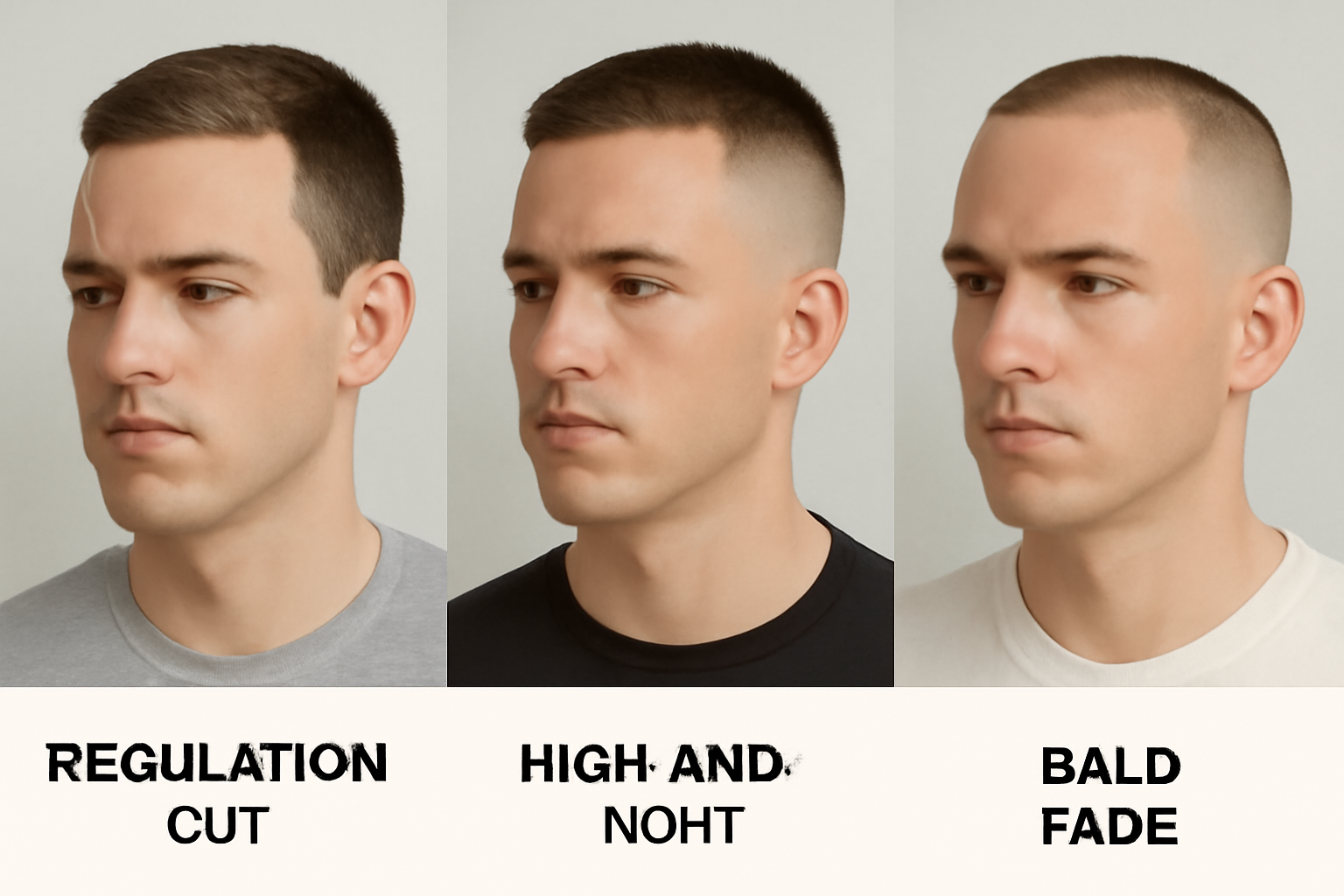
13. French Crop: Short and Easy to Style
The French crop is a close cousin to the Caesar but adds extra texture on top for a more modern vibe. Hair is cut short in the back and sides (guard #2) with a slightly longer, textured fringe that can be styled forward or swept to the side. A bit of lightweight paste helps separate layers and keep them in place without stiffness. Maintenance is minimal—just a trim every four weeks to keep the fringe at the right length.
14. Short Mohawk Fade: Unique and Stylish
Featuring a narrow strip of slightly longer hair down the center (about one inch) that tapers into a fade on each side, the short mohawk fade adds height and draws the eye to the middle of the head. Texturizing shears create softness along the strip, preventing it from looking too harsh. Use a dab of texturizing powder or sea-salt spray to lift the center section. Touch up the faded sides every three weeks to preserve the contrast.
15. Clean Shave: Boldly Own Your Look
Sometimes the most powerful style choice is the simplest: a completely shaven scalp. Remove all hair with a close shave (or zero-guard clipper), then focus on scalp health—exfoliate twice weekly, moisturize daily, and never skip SPF. This look sends a clear message of confidence and requires only a razor or clippers and a few minutes each morning. Shave every two to four days, depending on hair growth rate.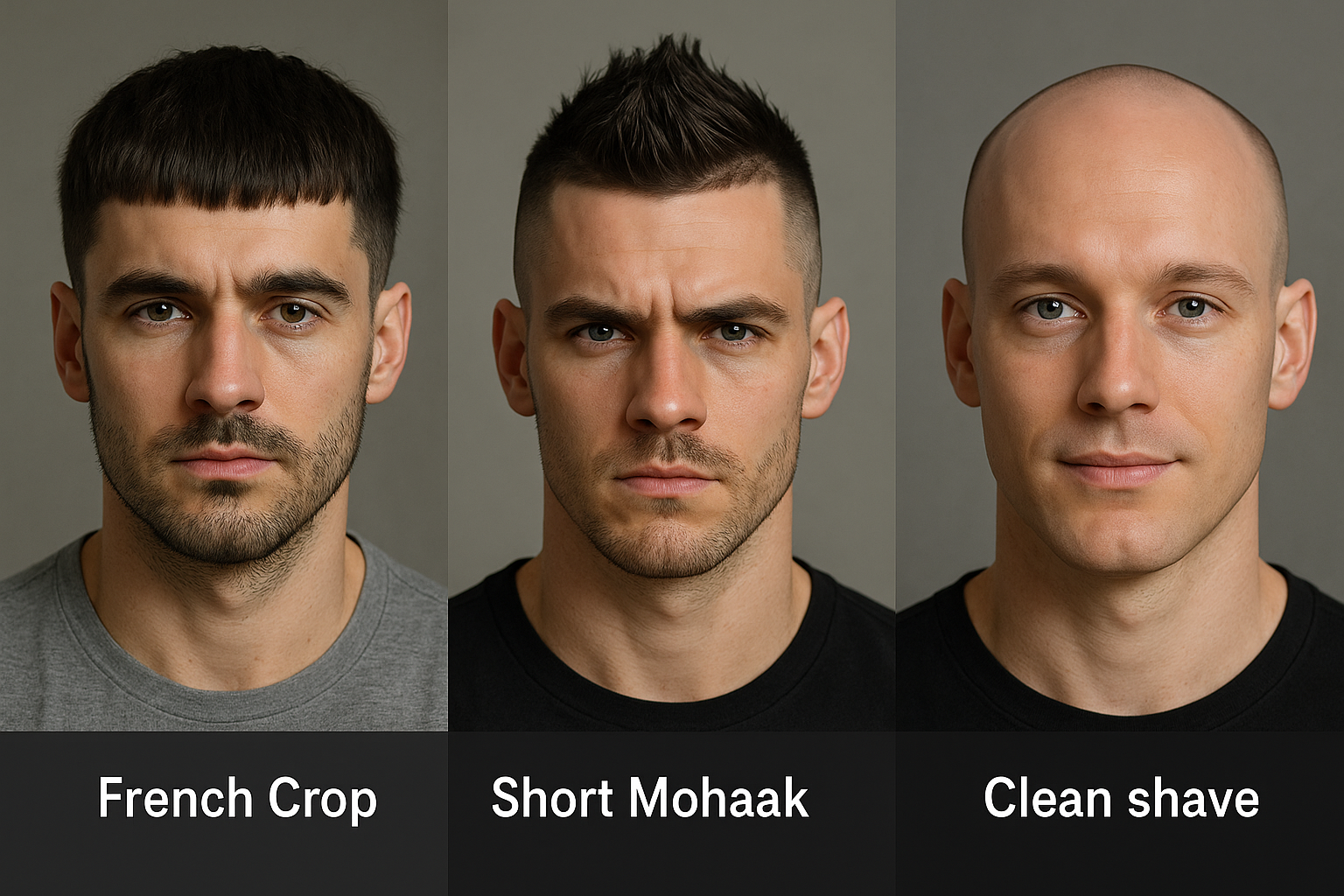
Common Mistakes to Avoid When Styling Balding Hair
Many men overuse heavy gels that flatten fine hair or choose clipper guards that leave uneven patches. Skipping scalp care—like hydration and sun protection—can lead to irritation and dryness. Copying a celebrity style without accounting for your own density often backfires. Learn from these missteps to get a reliable, flattering result.
Hairstyling Tricks to Create the Appearance of Thicker Hair
Lightly powder your roots to lift strands and mask scalp shine. Use a blow dryer on low heat, directing airflow at your roots while lifting with your fingers. Incorporate small, intermittent trims to remove wispy ends that accentuate thin spots. These simple tweaks deliver a fuller, more textured look.
If you’d like an even more dramatic transformation, consider a custom hair solution. At LaVividHair we offer hair systems, toupees, men’s wigs and hair patches—each crafted just for you. Our advantages include:
-
Professional Customization: We tailor density, base shape and hairline design to your unique balding pattern and lifestyle.
-
Exceptional Customer Service: From first consultation through aftercare, our experts guide you every step of the way.
-
Premium Materials: Breathable, lightweight bases and 100% human hair ensure a natural look and feel.
-
Wide Applicability: Solutions for every stage of hair loss, skin tone and face shape.
Below is a quick comparison to help you choose:
Explore our full range at LaVividHair and contact us for a free, no-obligation consultation—because you deserve a wig made just for you.
FAQs: Men’s Haircuts for Balding Hair
Does Short Hair Make Balding Less Noticeable?
Yes. Short cuts reduce contrast between hair and scalp, so thinning areas blend in more naturally. The closer the cut, the less room for visible gaps.
Should I Shave My Head If I’m Balding?
If you’re open to a bold, streamlined look, shaving can be liberating. It eliminates uneven patches and simplifies your routine. Pair it with proper scalp care to keep skin healthy.
Can Haircuts Actually Make Hair Look Thicker?
While they can’t change strand diameter, certain cuts—like textured crops and fades—create light and shadow that trick the eye into seeing more volume. Strategic layering is key.
Conclusion
Choosing the right haircut when you’re balding is about more than hiding hair loss—it’s a chance to redefine your style and boost your confidence. By considering your hair‑loss stage, face shape, and daily habits—and by selecting one of these fifteen proven cuts—you’ll achieve a look that feels authentic, low‑maintenance, and unmistakably you.
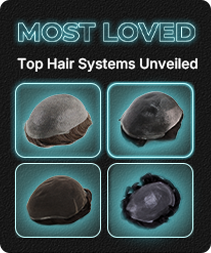


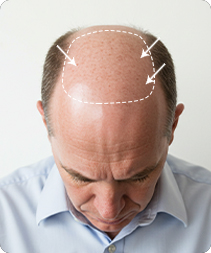
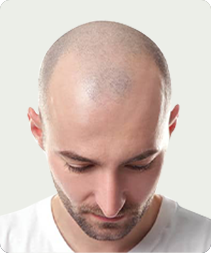
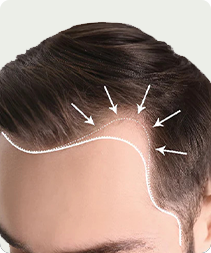













































Comments (0)